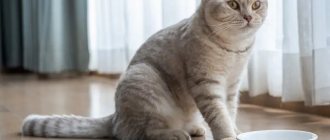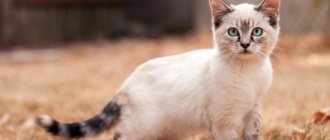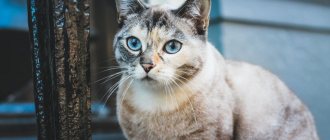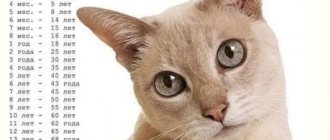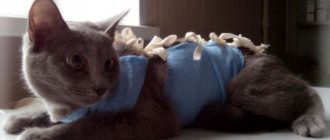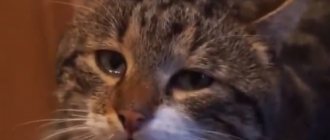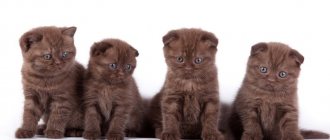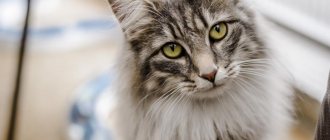Correspondence table with coefficients
You've probably heard that 1 year of a pet's life is equivalent to 7 human years. This is not the case with cats. Age directly depends on the speed of maturation - in childhood, any living creature grows as quickly as possible. The differences in age between humans and cats are due to differences in life expectancy.
Each month of a kitten’s life is equal to 2–3 human years. In childhood, this figure is 1:12, by the age of one year it grows to 1:15, then gradually begins to slow down to a ratio of 1:5. A table with compliance coefficients will help you navigate. These coefficients are based on the emotional and social differences inherent in a particular period.
| Age of the cat | Compliance factor | Human age |
| 1 month | 6–7 | 6–7 months |
| 2 months | 5–5,5 | 10–11 months |
| 3 months | 8–8,6 | 2–2.2 years |
| 4 months | 15–15,5 | 5–5.2 years |
| 5 months | 19,2–20,4 | 8–8.5 years |
| 6 months | 28–30 | 14–15 years old |
| 7 months | 25,7–26,5 | 15–15.5 years |
| 8 months | 24–24,75 | 16–16,5 |
| 1 year | 18–19 | 18–19 years old |
| 2 years | 12,5–13 | 25–26 years old |
| 3 years | 10–11 | 30–33 years |
| 4 years | 8,75–9,25 | 35–37 years old |
| 5 years | 8–8,6 | 40–43 years |
| 6 years | 7,1–7,6 | 43–46 years old |
| 7 years | 6,4-6,7 | 45–47 years old |
| 8 years | 6,25–6,63 | 50–53 years old |
| 9 years | 6,1–6,44 | 55–58 years old |
| 10 years | 6–6,3 | 60–63 years |
| 11 years | 5,6–5,9 | 62–65 years old |
| 12 years | 5,4 | 65–68 years old |
| 13 years | 5,2–5,46 | 68–71 years |
| 14 years | 5,1–5,2 | 72–73 years old |
| 15 years | 4,9–5 | 74–75 years old |
| 16 years | 4,75–4,8 | 76–77 years old |
| 17 years | 4,5–4,6 | 78–79 years old |
| 18 years | 4,4–4,7 | 80–85 years |
| 20 years | 5 | 100 years |
A six-month-old kitten most closely resembles a teenager, and an elderly 20-year-old cat can be considered as long-lived as a 100-year-old person. These calculations can be relied upon when trying to determine what life stage your pet is in.
Cat age
When purchasing a furry friend, the owner and household members must understand that cats do not live as long as humans. When figuring out how many years a cat goes through a year, the owner is most often interested in the animal’s life expectancy. An indicator such as the average life expectancy of furry couch potatoes depends on many factors:
| Factors influencing life expectancy | Rationale |
| Breed | Breeds such as the Siamese and Burmese are considered long-lived in the cat world. Their life expectancy is on average 18 years, many individuals live up to 20 - 24 years. Pets of such a popular breed as the British live on average 15 years |
| Habitat | Homeless and street cats live on average no more than 5 years. Such a short period of life is due to the dangers that await the animal in the wild, malnutrition, hypothermia, frequent births, and lack of veterinary treatment. Most street cats die in fights or from viral infections. |
Cats do not live long due to endless childbirth and related complications. Pets live much longer compared to their street relatives. On average, the life expectancy of furry couch potatoes is 14 - 15 years
Of course, the lifespan of a cat is a very average indicator. Pets are known to live 30 years or more. However, such long-livers are rather an exception in the world of furry couch potatoes.
Approximate ratio
Each year of a cat’s life is equivalent to several years of a human, but at different stages this ratio changes. When there are no calculations at hand, you can roughly estimate the age of the animal using the following rules:
- The first year of a cat is 15 human years.
- By the end of her second year, she “turns” 24.
- From the third year until the age of 16, each year counts as 4.
- From the age of 16 you can add 3 years.
For example, the tailed one is 10 years old. By human standards, his age is 56 years. We add 24 (because the animal is already 2 years old) and the result of multiplying 4 (from the third year, each cat year is 4 human years) by 8 (10 is 2 years, which we have already taken into account). We get 56.
24 + 4*8 = 56 (years)
This is a rather rough calculation that allows you to determine who is in front of you: an adult or an elderly pet. If you need to understand a more accurate ratio, it is better to use the ready-made calculation with the coefficients given above.
One of the well-known ways to calculate how old a cat is is to multiply by 7. That is, in the first year the cat is 7 years old in human years, in the second - 14, in the third - 21, and so on. This is not entirely true, because at one year old a cat is already quite independent, which cannot be said about a seven-year-old child. Additionally, 20-year-old cats are much more common than 140-year-old humans. Thus, the theory of multiplication by 7 is far from true.
Mature cats - from seven to ten years
Once your pet reaches about seven or eight years of age, some veterinarians may begin to treat her as a geriatric cat. In fact, the rate of development of cats is uneven, and at this age it is too early to retire Murka. Although cats who are nine or ten years old might be eligible for a social security card or superannuation if they were human, it is too early to talk about retirement age.
This is an important age to double-check that your aging cat is getting the right nutrition. Indicators of this are the absence of dental problems, kidney disease, and heart murmurs. The most accurate guide to good health is behavior. If the cat can still jump easily and sometimes ruin things, she is doing well. Blood tests should be compared with those taken in youth to ensure there are no trending changes in organ function. More frequent checks with a veterinarian are recommended, since by human standards the cat is already about 60 years old.
Correlation between the ages of cats and humans by period
When we try to calculate how old a cat is in human years, we usually pay attention to what period of life she lives through. After all, both animals and people go through 4 stages: child, teenager, adult, old. And, like people, cats behave differently at different times in their lives.
In the first year of life, the kitten, having separated from its mother, learns to live alone. Two-month-old kittens are babies who still need milk and maternal care. From 2.5-3 months, babies are given to new, two-legged parents, and they take on the responsibilities of the mother. But the foundation has already been laid: the little one already knows how to feed and defecate on his own. He gained skills in grooming and hunting.
Three-month-old kittens are given to new owners because the pets can already take basic care of themselves.
Until one year, the kitten studies a lot, plays, learns the habits of its owners - grows and develops. From the age of two, a cat already understands well how to get what she wants from her owner. She develops habits and habits. This is a young animal.
Conventionally, from the age of seven to ten, a cat begins to show signs of aging. Gradually, she loses interest in active games, dementia may develop (which is absolutely normal), and the habit of meowing for no reason may appear. During this period, chronic diseases make themselves known.
Life can be divided into a larger number of segments, highlighting the first and second periods of maturity and childhood. But for convenience, we will use four categories.
| Period | Age of the cat |
| Childhood | 0–6 months |
| Teenage years | 6–12 months |
| Adult | 1–10 years |
| Elderly | Over 10 years old |
In animals, as in humans, strict age limits cannot be defined. Many cats are as energetic at 15 years old as they were when they were young. Kittens of some breeds are not characterized by excessive activity. If a cat has chronic illnesses or is in pain, it will age faster. On the contrary, if you provide a comfortable and safe environment for your cat, she is more likely to live a long, active life.
Childhood (3-4 – 6 months)
A kitten, like a child, actively explores the world and reaches out to its elders (keep in mind that the owner is like a parent for a kitten). Physically, he is growing very quickly, and his irrepressible energy and thirst to explore everything around him require active action. On the one hand, this is a very interesting period for observing a kitten - every day will bring something new. On the other hand, it’s not for nothing that they say that disadvantages are the other side of advantages (as well as vice versa). All this is very good if you or someone in your family are willing to devote a lot of time to the kitten (at least several hours a day): for play, for feeding 6-7 times a day, for frequent visits to the veterinarian (like children, kittens often get sick). You need to be prepared for sleepless nights (however, active games during the day will allow you to sleep better), for overturned things (and, if you are careless, broken), and for the fact that the kitten will require a lot of attention. If you are not ready for this, if you don’t have time for this, then you yourself will miss such an interesting stage in your pet’s life, and you will make him unhappy, perhaps even jeopardizing his health. Or the kitten will simply find something to do alone, and you will be angry about the disorder in the apartment and, in the worst case, decide to part with it.
To avoid all this, if you have a shortage of free time, we recommend that you take an adult pet - it is calmer and more independent and can tolerate loneliness more easily.
Read more: Adopting an adult cat is not a problem!
How to determine the age of a cat by appearance
You can find out how many months a kitten is in different ways. A three-month-old kitten is very different from a two-month-old one. With adults, everything is a little different; it is difficult to distinguish a 3-year-old cat from a ten-year-old cat. Here's what you should pay attention to.
- Body. Young cats have a softer body, their muscles have not yet been hardened by training (and fighting, if we are talking about street animals).
- Teeth. The easiest way to determine age is by teeth. Problems with them begin after 1–2 years of a cat’s life. If visually everything is in order, there is no strong plaque or inflammation of the gums, then the animal is most likely young. Cats' baby teeth change at 7 months.
- Wool. In older cats, the fur becomes rough, falls out in places, and has bald patches near the ears.
- Muzzle. The muscles and skin of old animals lose tone, so that in many representatives the muzzle sags a little and a “tired” expression appears.
When comparing the age of an animal with a human, pay attention to the fact that old age comes faster to cats. A 22-year-old cat is equivalent to a grandmother at the age of 105. A long-lived woman of advanced age requires special treatment.
The age is best determined by a veterinarian. He knows what the development of a kitten looks like from birth. Experience tells the doctor what age the animal is in front of him. Most experts determine how old a pet is by its teeth, or rather, by the degree of their development and wear. This is perhaps the most accurate “calculator”.
Nutrition depending on age
At each individual period of life, cats need a certain diet. What will invigorate an active kitten, the stomach of an old pet simply cannot digest.
Owners of small kittens should definitely prepare a menu rich in vitamins for them. The diet should include fermented milk products, boiled meat and fish. The yolk is also good for babies. And vegetables and semolina will help kittens grow healthy and active.
An adult cat needs a nutritious diet no less. Depending on the breed, the menu should include meat products. Occasionally you can treat your pet to fish. But only if he is not sterilized!
Fermented milk products in small portions will help improve digestion, and porridge and boiled vegetables will saturate the animal with essential vitamins.
Elderly animals need a special menu. Due to dental problems, cats need soft or crushed food. You should also prevent your pet from becoming obese. If it’s difficult to feel the ribs on your cat’s body, then it’s time to reduce the portion. The diet of an old animal must be balanced, it must contain calcium and taurine.
What affects a cat's lifespan?
The age of a cat is influenced by many factors. Not all of them can be made positive by the owner. But most can be corrected by the owner. What makes up a long and happy cat's life?
- Minimizing stress. For cats, these are different events: moving, the arrival of a new person or pet in the house, a new owner, illness. You can prepare for many events in advance, give you calming drops, and help you adapt to a new territory.
- Proper nutrition. Undoubtedly, species-typical food is more suitable for a domestic predator. Cats have been eating this way for thousands of years, naturally and naturally.
- Active lifestyle. Health is directly affected by how much our furries move. Mobility is important for joints, internal organs, metabolic processes, and a stable mental state. If your cat tends to spend time sleeping, offer her active games, new toys, and go for walks. Equip a complex and climbing frames for your pet.
- Walking is under control. Unfortunately, cats that walk on their own live shorter lives. A sharp car horn, evil people, dogs, viruses, poisoning - all this awaits a cat outside the threshold, no matter how smart and quick-witted it is. Walking on a harness is ideal.
- Preventive examinations. Visit the veterinarian once a year, vaccinate your pet, and take the necessary tests. After 7 years or in case of a chronic disease, it is recommended to undergo examinations more often, once every six months.
- Sterilization and castration. This significantly reduces mammary gland tumors in cats and prostatitis in cats. There is no unnecessary stress due to estrus, and there is no need to use dubious anti-estrus remedies. But before sterilization, conduct examinations.
How long and how a cat will live depends directly on the owner.
Of course, the owner's love and affection directly affect the mental and physical state of the cat. Animals that are cared for and their needs met live longer.
How to prolong a pet's life?
Be attentive to your pet: learn to recognize signals indicating that the cat is sick. Our domestic carnivores are good at hiding pain, so your observation and discipline can prolong the animal's life.
Proper, species-specific nutrition will help prolong your pet’s life. The sooner you start feeding your domestic predator the way nature intended, the higher the chance of avoiding serious illnesses in old age. SUPERPET is a species-typical BARF food that contains everything necessary for the development and maintenance of cat health. This is a raw diet for daily feeding.
By keeping an eye on your pet's health and wrapping it in care and affection, you can celebrate your cat's “centenary” anniversary.

